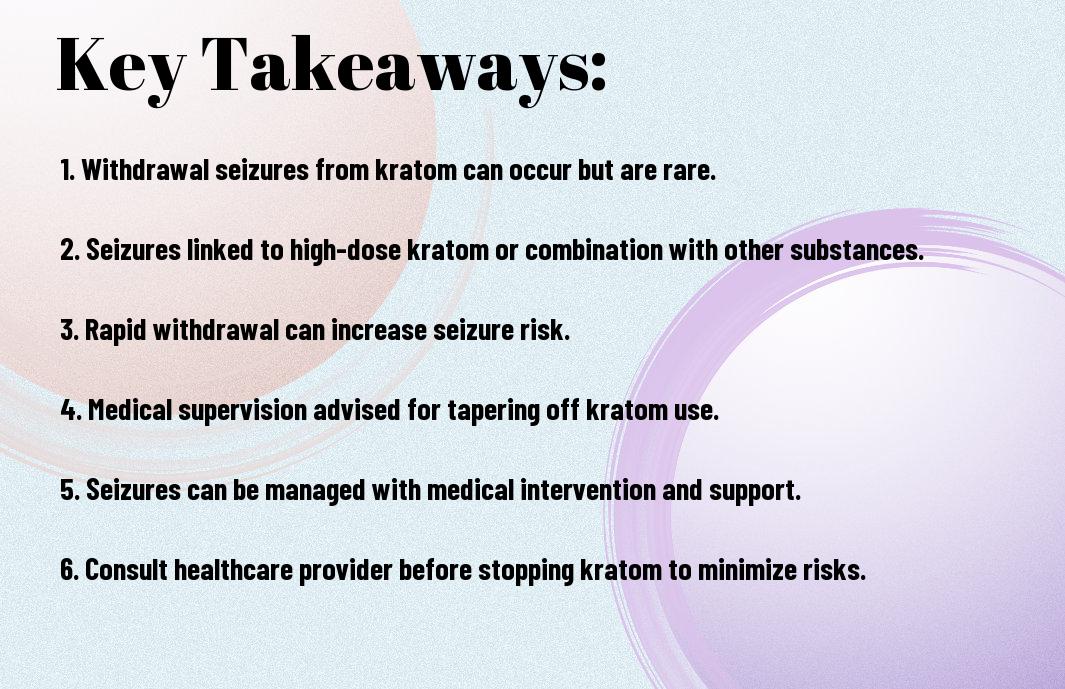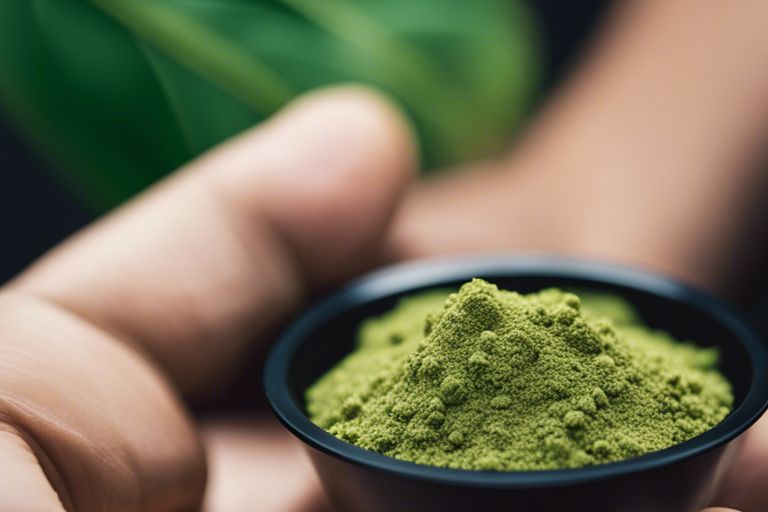Deprecated: mb_convert_encoding(): Handling HTML entities via mbstring is deprecated; use htmlspecialchars, htmlentities, or mb_encode_numericentity/mb_decode_numericentity instead in /home/users/kratomfiles/www/kratomfiles.com/wp-content/plugins/quick-adsense-reloaded/includes/template-functions.php on line 3552
Withdrawal from kratom can lead to various unpleasant symptoms, with seizures being one of the most severe and dangerous. Kratom, a plant native to Southeast Asia, has gained popularity as a natural remedy for pain relief and mood enhancement. However, its addictive properties can cause physical and psychological dependence, resulting in withdrawal symptoms when abruptly discontinued. It is crucial to be aware of the potential risks, including seizures, associated with kratom withdrawal and seek professional help for a safe tapering process.
Key Takeaways:
- Seizure Risk: Withdrawal from kratom can increase the risk of seizures in some individuals.
- Neurological Symptoms: Seizures are a serious neurological symptom that may require medical attention during kratom withdrawal.
- Consult a Healthcare Provider: If you are experiencing seizures or any other concerning symptoms during kratom withdrawal, seek medical help immediately.

What is Kratom?
A popular herbal supplement, kratom is derived from the leaves of Mitragyna speciosa, a tropical tree native to Southeast Asia. It has gained popularity in Western countries for its potential medicinal and recreational effects, with claims ranging from pain relief to mood elevation.
Origins and History
The use of kratom dates back centuries in countries like Thailand, Indonesia, Malaysia, and Papua New Guinea, where it was traditionally consumed by chewing the fresh leaves or brewing them into tea. Kratom has long been employed for its stimulating and sedative properties, often used to combat fatigue and for its analgesic effects.
Chemical Composition
Any comprehensive understanding of kratom involves delving into its chemical makeup, particularly its alkaloid content. The primary alkaloids in kratom, such as mitragynine and 7-hydroxymitragynine, interact with opioid receptors in the brain, producing various effects that mimic those of opioids.
This unique chemical composition is what renders kratom potent and potentially addictive. While these alkaloids may offer pain relief and mood enhancement, they can also lead to tolerance, dependence, and withdrawal symptoms with chronic use.
Kratom Withdrawal Symptoms
Common Symptoms
Symptoms of kratom withdrawal can vary in severity and duration, with some being more common than others. Common symptoms include muscle aches, insomnia, irritability, yawning, runny nose, diarrhea, and mood swings. These symptoms typically start within 12-24 hours after the last dose of kratom and can last for several days.
Rare but Serious Symptoms
Kratom withdrawal may also present with less common but serious symptoms such as seizures, hallucinations, and severe cravings. These symptoms may require immediate medical attention and should not be taken lightly. It is important to seek medical help if experiencing any of these severe symptoms during kratom withdrawal.
With seizures being one of the rare but serious symptoms of kratom withdrawal, it is crucial to be aware of the risks involved when coming off kratom. Those with a history of seizures or underlying medical conditions may be at higher risk of experiencing seizures during withdrawal from kratom.
Duration of Withdrawal
Symptoms of kratom withdrawal typically peak within 2-3 days after stopping use and then gradually decrease over the course of a week. However, some individuals may experience protracted withdrawal symptoms that can last for weeks or even months after discontinuing kratom use.
This information emphasizes that although kratom withdrawal symptoms can be challenging, they are manageable and temporary. Seeking support from healthcare providers or addiction specialists can aid in the management of withdrawal symptoms and increase the likelihood of a successful recovery from kratom dependence.
Seizures and Kratom Withdrawal
The Link Between Kratom and Seizures
Seizures can be a serious consequence of kratom withdrawal. According to a study published in the Journal of Medical Toxicology, a case report titled Seizure and Coma Following Kratom (Mitragynina speciosa Korth) Exposure documented a patient who experienced a seizure and subsequently fell into a coma after kratom use.
Types of Seizures Associated with Kratom Withdrawal
Seizures associated with kratom withdrawal can vary in type and severity. The main keywords include tonic-clonic seizures, focal seizures, myoclonic seizures, and absence seizures. Perceiving the type of seizure is crucial for appropriate management and treatment.
| Tonic-Clonic Seizures | Focal Seizures |
| Myoclonic Seizures | Absence Seizures |
| Perceiving |
Risk Factors for Seizures
- Seizures associated with kratom withdrawal may be influenced by various risk factors.
Knowing the risk factors can help in identifying individuals who may be more susceptible to experiencing seizures during kratom withdrawal.

Causes of Seizures During Kratom Withdrawal
Neurotransmitter Imbalance
An imbalance in neurotransmitters, such as serotonin and dopamine, can occur during kratom withdrawal. These imbalances often lead to changes in brain activity and can increase the likelihood of experiencing seizures. During withdrawal, the brain struggles to regulate these chemicals, which can result in disruptions to the nervous system and trigger seizures.
Dehydration and Electrolyte Imbalance
Any abrupt cessation of kratom can lead to physical symptoms like vomiting, diarrhea, and excessive sweating, which can cause dehydration and electrolyte imbalances. Dehydration can lead to an imbalance of vital minerals in the body such as sodium, potassium, and magnesium, which are crucial for proper nerve function. These imbalances can trigger seizures during withdrawal as the body tries to readjust to the absence of kratom.
This emphasizes the importance of staying hydrated and replenishing electrolytes during kratom withdrawal to help prevent seizures and other potential complications.
Underlying Medical Conditions
Causes such as epilepsy, brain injuries, or other neurological disorders can also contribute to an increased risk of seizures during kratom withdrawal. Underlying medical conditions can make the brain more susceptible to the effects of withdrawal, making seizures more likely to occur in these individuals.
Recognizing and addressing any underlying medical conditions before initiating kratom use can help reduce the risks associated with withdrawal and potential seizure activity.
Diagnosis and Treatment of Seizures
Medical Evaluation and Testing
To properly diagnose seizures resulting from kratom withdrawal, a medical professional will conduct a thorough evaluation including a physical exam, review of symptoms, and medical history. Medical imaging tests such as CT scans or MRIs may be ordered to rule out other potential causes of seizures. Blood tests might also be conducted to assess electrolyte levels and check for any underlying medical conditions.
Medications for Seizure Control
Evaluation for seizure control focuses on prescribing appropriate medications to manage and prevent seizures. A healthcare provider may recommend anticonvulsant drugs to help regulate brain activity and reduce the likelihood of recurrent seizures. The dosage and type of medication will be determined based on the individual’s specific needs and response to treatment.
Seizures must be closely monitored, and any adjustments to medication should be made under the supervision of a healthcare provider to ensure effectiveness and minimize side effects. Compliance with the prescribed medication regimen is crucial in controlling seizures and improving overall quality of life.
Lifestyle Changes and Support
One of the crucial aspects of managing seizures is making lifestyle changes to reduce triggers and promote overall well-being. This may include getting an adequate amount of sleep, maintaining a healthy diet, managing stress levels, and avoiding substances that can lower the seizure threshold. Support groups and counseling can also be beneficial in coping with the emotional and psychological impact of seizures.
Seizures can be a complex medical condition that requires a comprehensive approach involving medical treatment, lifestyle modifications, and ongoing support. By working closely with healthcare providers and making necessary lifestyle changes, individuals can effectively manage seizures and lead a fulfilling life.
Preventing Seizures During Kratom Withdrawal
Gradual Tapering of Kratom Use
Many individuals find that the best way to prevent seizures during kratom withdrawal is by gradually tapering off their kratom use. By slowly reducing the dosage over time, the body has a chance to adjust to lower levels of the substance, lowering the risk of severe withdrawal symptoms such as seizures.
Staying Hydrated and Managing Electrolytes
Preventing seizures during kratom withdrawal also involves staying hydrated and managing electrolyte levels in the body. Proper hydration is imperative in order to help the body flush out toxins and maintain overall health. Electrolytes such as potassium and sodium are crucial for nerve function and muscle contraction, so maintaining proper levels is important in reducing the risk of seizures.
Seeking Professional Help
For individuals experiencing severe kratom withdrawal symptoms or those at risk of seizures, seeking professional help is crucial. Medical professionals can provide guidance and support throughout the withdrawal process, ensuring a safer and more comfortable experience. They may also prescribe medications to help manage symptoms and reduce the risk of seizures.
Can Kratom Withdrawal Lead to Seizures?
Yes, using kratom for withdrawal relief can lead to seizures. While kratom can help manage withdrawal symptoms from opiates, it can also cause withdrawal symptoms of its own. Seizures are a potential risk, especially when using high doses of kratom or mixing it with other substances. It’s important to use kratom responsibly.
Summing up
To wrap up, experiencing seizures during kratom withdrawal is a rare but serious potential side effect. It is crucial for individuals trying to quit kratom to seek medical assistance and support to ensure a safe and monitored detox process. To learn more about Kratom Withdrawal Symptoms, Timeline & Detox Treatment, visit here.
FAQ
Q: What is kratom withdrawal?
A: Kratom withdrawal refers to the physical and psychological symptoms that occur when a person who is dependent on kratom suddenly stops using it. These symptoms can range from mild to severe, depending on the individual’s usage and dependency level.
Q: Can kratom withdrawal cause seizures?
A: Yes, in some cases, kratom withdrawal can lead to seizures. Seizures are a rare but serious potential complication of stopping kratom use abruptly, especially in individuals who have been using high doses for a prolonged period of time.
Q: What are the common symptoms of kratom withdrawal?
A: Common symptoms of kratom withdrawal include anxiety, irritability, muscle aches, insomnia, nausea, sweating, tremors, and in some cases, seizures. The severity and duration of these symptoms can vary from person to person.
Q: How can seizures from kratom withdrawal be prevented?
A: To reduce the risk of seizures during kratom withdrawal, it is important to taper off kratom use gradually instead of stopping abruptly. Seeking medical assistance for a supervised detoxification process can also help in managing withdrawal symptoms and reducing the risk of seizures.
Q: When should someone seek medical help for kratom withdrawal symptoms?
A: If someone experiences seizures or severe symptoms during kratom withdrawal, they should seek immediate medical attention. It is crucial to consult a healthcare professional for proper evaluation, guidance, and support during the withdrawal process to ensure safety and well-being.










